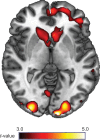Preliminary Evidence for Disrupted Nucleus Accumbens Reactivity and Connectivity to Reward in Binge Drinkers
- PMID: 29016710
- PMCID: PMC5860287
- DOI: 10.1093/alcalc/agx062
Preliminary Evidence for Disrupted Nucleus Accumbens Reactivity and Connectivity to Reward in Binge Drinkers
Abstract
Aims: Dysfunctional brain reward circuitry, particularly in the nucleus accumbens (NAcc), has been proposed as a risk factor for alcohol use disorder (AUD). This risk factor may be evident in binge drinkers (BD), who are at high risk for developing AUD. We examined whole-brain and NAcc reactivity to reward in BD compared to non-binge drinkers (NBD), hypothesizing that groups would differ in their neural reactivity and connectivity.
Methods: Healthy BD (N = 27) and NBD (N = 23)-none meeting AUD criteria-completed a reward-guessing game, the 'Doors' task, during functional magnetic resonance imaging. We conducted an exploratory whole-brain search for group differences, but given our a priori hypotheses, we also extracted activation from the NAcc to examine reactivity during reward (Win > Loss) and functional connectivity (FC) to the prefrontal cortex.
Results: Compared to NBD, BD exhibited greater activation in both the right and left NAcc during reward relative to loss. Additionally, NBD drinkers exhibited positive FC between the NAcc and dorsal anterior cingulate (dACC) whereas the BD showed negative FC between these regions. Furthermore, less NAcc-dACC FC was related to more past month alcohol use.
Conclusions: Our results provide preliminary evidence that BD exhibit greater NAcc activation during reward receipt relative to loss. This is consistent with the broader AUD literature and suggests aberrant neural reactivity may precede disorder onset. In addition, BD exhibited less NAcc-dACC FC, perhaps reflecting deficient regulation of activation to rewards compared to losses. This profile of reward brain circuitry could represent neural correlates of vulnerability for AUD.
Short summary: Healthy binge drinkers, at risk for alcohol use disorder, exhibited greater nucleus accumbens activation during reward relative to loss. In addition, binge drinkers exhibited reduced connectivity between the nucleus accumbens and dorsal anterior cingulate, which was associated with more past month alcohol use.
© The Author 2017. Medical Council on Alcohol and Oxford University Press. All rights reserved.
Figures



Similar articles
-
Amygdala-orbitofrontal functional connectivity mediates the relationship between sensation seeking and alcohol use among binge-drinking adults.Drug Alcohol Depend. 2018 Nov 1;192:208-214. doi: 10.1016/j.drugalcdep.2018.07.044. Epub 2018 Sep 18. Drug Alcohol Depend. 2018. PMID: 30268936 Free PMC article.
-
Abnormal functional connectivity within the reward network: a potential neuroimaging endophenotype of bipolar disorder.J Affect Disord. 2021 Feb 1;280(Pt B):49-56. doi: 10.1016/j.jad.2020.11.072. Epub 2020 Nov 11. J Affect Disord. 2021. PMID: 33221607
-
Binge drinking is associated with altered resting state functional connectivity of reward-salience and top down control networks.Brain Imaging Behav. 2020 Oct;14(5):1731-1746. doi: 10.1007/s11682-019-00107-6. Brain Imaging Behav. 2020. PMID: 31073695 Free PMC article.
-
The differential neural substrates for reward choice under gain-loss contexts and risk in alcohol use disorder: Evidence from a voxel-based meta-analysis.Drug Alcohol Depend. 2023 Jul 1;248:109912. doi: 10.1016/j.drugalcdep.2023.109912. Epub 2023 May 4. Drug Alcohol Depend. 2023. PMID: 37182355 Review.
-
Common and distinct networks underlying reward valence and processing stages: a meta-analysis of functional neuroimaging studies.Neurosci Biobehav Rev. 2011 Apr;35(5):1219-36. doi: 10.1016/j.neubiorev.2010.12.012. Epub 2010 Dec 24. Neurosci Biobehav Rev. 2011. PMID: 21185861 Free PMC article. Review.
Cited by
-
Win and Loss Responses in the Monetary Incentive Delay Task Mediate the Link between Depression and Problem Drinking.Brain Sci. 2022 Dec 9;12(12):1689. doi: 10.3390/brainsci12121689. Brain Sci. 2022. PMID: 36552149 Free PMC article.
-
Loss and Frontal Striatal Reactivities Characterize Alcohol Use Severity and Rule-Breaking Behavior in Young Adult Drinkers.Biol Psychiatry Cogn Neurosci Neuroimaging. 2022 Oct;7(10):1007-1016. doi: 10.1016/j.bpsc.2022.06.001. Epub 2022 Jun 13. Biol Psychiatry Cogn Neurosci Neuroimaging. 2022. PMID: 35709958 Free PMC article.
-
Effects of familial risk and stimulant drug use on the anticipation of monetary reward: an fMRI study.Transl Psychiatry. 2019 Feb 4;9(1):65. doi: 10.1038/s41398-019-0399-4. Transl Psychiatry. 2019. PMID: 30718492 Free PMC article.
-
Neuroimaging in alcohol use disorder: From mouse to man.J Neurosci Res. 2022 May;100(5):1140-1158. doi: 10.1002/jnr.24423. Epub 2019 Apr 22. J Neurosci Res. 2022. PMID: 31006907 Free PMC article. Review.
-
Adolescent brain maturation and the neuropathological effects of binge drinking: A critical review.Front Neurosci. 2023 Jan 17;16:1040049. doi: 10.3389/fnins.2022.1040049. eCollection 2022. Front Neurosci. 2023. PMID: 36733924 Free PMC article. Review.
References
-
- Bjork JM, Knutson B, Hommer DW (2008. a) Incentive-elicited striatal activation in adolescent children of alcoholics. Addiction 103:1308–19. - PubMed
MeSH terms
Grants and funding
LinkOut - more resources
Full Text Sources
Other Literature Sources
Miscellaneous

